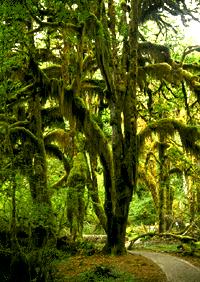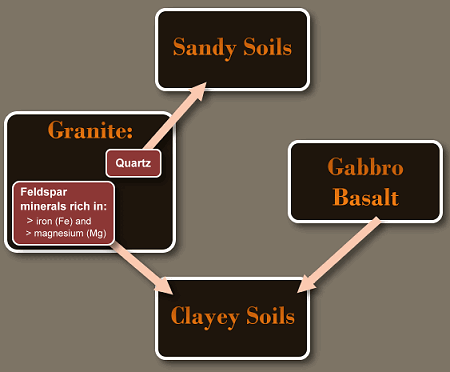Introduction:
Parent material of organic soils comes from the remains of plants and animals.
Parent material of mineral soils comes from:

Crystalline Rocks:
Crystalline rocks are made up of crystals.
Crystalline rocks include granites, gabbros, basalts, and associated metamorphic rocks.
Normally found buried under rock material such as sandstone or shale, crystalline rocks underlie about one-quarter of the Earth.
Granite forms soils that contain a fuIl range of particle sizes, from gravel and sand to very fine clays. Like bits of glass, the quartz mineral grains of granite are very resistant to weathering, becoming gritty sand in soil.
Other less resistant minerals in granite such as feldspar and dark minerals rich in iron and magnesium weather to form fine clay particles.
Gabbro is coarse grained and black, basalt fine grained and grey. Since gabbro and basalt contain no quartz, the soils they form are not sandy but are clayey and sticky.
The soils formed are often quite red and rather fertile.

Sedimentary Rocks:
Sedimentary rocks underlie about three-quarters of the land area of the earth.
Erosion and weathering formed material which deposited as soft layers of sediment on the bottoms and shores of ancient seas.
Muds deposited offshore, sand deposited nearer the shores. These deposits slowly hardened to form sedimentary rocks. The sea bottom uplifted, becoming dry land. Weathering and erosion of the sedimentary rocks began, soils forming from them.
Recent Cover Deposits:
click diagrams for explanation
Recent cover deposits are geologically young sediments.
They include:
 |
crystalline rocks |
 |
sedimentary rocks |
 |
recent cover deposits. |
Click this link to download Resource Diagram Notes on Cover Deposits (PDF)
 |
Cover sands - most commonly deposited by water from erosion of sandstone. Wind may shift these cover sands to form dunes.
|
 |
Loess - a wind transported deposit consisting mainly of silt from floodplains of rivers whose source is a glacier.
The silts produce fertile agricultural soils with excellent water-holding capacities that are also rich in plant nutrient-bearing minerals. Loess deposits occur in such places as Canterbury, Otago and Hawkes Bay.
|
 |
Colluvium is material deposited under the influence of gravity at the base of hills or mountains.
Colluvium can be derived from a variety of sources such as rockslides or a lahar - these deposits are therefore very variable in composition.
|
 |
Glacial deposits - left by the glaciers that repeatedly advanced and retreated one million to 10,000 years ago, the deposits often have a covering of loess, are parent materials of soils in much of New Zealand.
The mixture of stones, sand, silt, and clay carried along by glaciers was deposited in broad blankets and ridges called moraines.
Lakes which once existed near the glaciers often became filled with rich silty and clayey soils to form good farmland. |

 |
Volcanic ash - widespread from south Waikato to Taranaki. Although the mineralogy of volcanic ash is variable, most of it develops into good-quality soils.
|
 |
Alluvium - forms soils rich in topsoil materials brought down from upland regions.
Alluvial soils form in valleys from sediments deposited by rivers and streams. Centuries of erosion have created fertile floodplain areas in NZ.
Alluvial soils are layered, with each layer representing the deposit of a flood. Usually sandy near river banks, alluvial soils can become clayey and even peaty in swampy areas. |
Instructions: click on the diagram for soil and rock pictures.